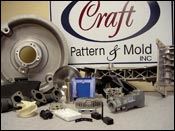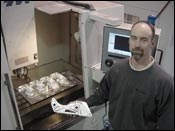Cutting Delivery Time 50 Percent With the Right CAD/CAM Package
With the appropriate CAD/CAM software behind it, one mold shop plans to further reduce its mold tooling turnaround time and remain a supplier of choice for its customers.
Craft Pattern & Mold, Inc (Maple Plain, MN) provides rapid precision plastic or metal prototypes and low-volume production parts for leading companies in the aerospace, agriculture, automotive, consumer products, electronics, medical and toy industries. Survival in these industries depends on rapid response to changes in part designs and production volumes.
Like other successful companies in the moldmaking and casting business, Craft is a small, agile company that is able to turn many jobs quickly and accurately. Increasing the speed of its turns is key for customer service and shop uptime. One of the major tools it uses to accomplish its mission is CAD/CAM software from Delcam—specifically, PowerMILL CAM software and PowerSHAPE to manipulate the surface form of CAD models.
Software Solution
Established in 1986 to provide high quality molds and patterns for the foundry industry, Craft Pattern can ship machined prototype parts within 14 days of receiving the customer’s CAD file. Since 1998, the 21-year old company has used the Delcam software to deliver cost-effective prototypes to its customers to check form, fit, function, and to evaluate a new product design.
According to Owner Tony Cremers, “By combining our technical knowledge with the latest manufacturing technologies we are dramatically reducing the development time for our clients. We partner with our clients to develop a complete project plan to meet strict budget, quality and delivery goals.”
According to Cremers, the Delcam software allows his company to create models and secondary tooling in a day or even hours. “Previously, it might have taken up to a month to turn around castings or machined parts, but with the Delcam software, we can go from the customer’s CAD file to patterns to castings in one to two—which helps our customers quite a bit,” Cremers says.
Once a pattern is designed, the company uses a series of machining centers to create patterns, core boxes and finished machined castings. Milltronic and HURCO CNC mills are used to machine the patterns and prototype machining. The company has a total of 16 CNC mills, and the Delcam software is essential to keeping the spindles turning.
“With our manufacturing capability that includes metal casting, production tooling and prototype tooling, machining plastic parts, injection molds and injection molded parts, Delcam PowerMILL helps to keep us operating smoothly,” Cremers notes, “and to meet our customer’s schedules on time while enabling the company to work on multiple projects simultaneously. For example, a pattern maker can use the software to generate an efficient toolpath that he knows will work well the first time, get the program out to a mill, and then get on to programming a subsequent job while the previous job is running. The speed with which we can create paths not only keeps delivery times to a minimum, but keeps our shop running consistently. The shop turns out foundry tooling 50 percent faster today than it could before we brought Delcam into the company.” Today, Craft has four seats of PowerMILL/PowerSHAPE.
Application
Recently, Craft received an order for tooling for a pulley wheel for a paint shaker from a customer who wanted to cast the part the next day. According to Cremers, meeting the need was possible with Delcam. Craft modified the CAD file, pulled a parting line out, generated a toolpath, cut the part and delivered it that afternoon.
“When we get a pattern to work with, such as a manifold from the agricultural equipment industry, we bring the customer’s part file into PowerSHAPE. We then easily break out the component parts, (cores, the outside shape and the core boxes) in order to create a pattern we can use to produce the prototype parts,” Cremers explains.
“With PowerSHAPE we can analyze the model for damaged, duplicated or missing surfaces. And we can interactively inspect draft angles, visualize hard-to-mold regions such as thin walls and ribs and undercut areas. We use process-driven Wizards to extract cavities, cores and slides straight from imported geometry. And we can repair, replace or modify surface or solid models,” continues Cremers. Craft completes work quickly and accurately.
Features
PowerSHAPE saves hours of pattern design time with a feature called Smart Surfacing. It blends fillets and radiuses automatically. It has always provided a number of alternative methods for constructing a surface from a given set of lines, arcs or points. But with Smart Surfacing, the choice of method is made automatically by the software to give the best possible (smoothest) surface.
Smart Surfacing also permits the software’s selection to be updated automatically as information is added to the design. As any additional lines or points are inserted into the model, PowerSHAPE reviews the chosen surfacing method and regenerates the surface automatically, giving an alternative solution if a better one exists.
“Then, once the file is imported into PowerMILL,” Cremers says, “it is easy to program the machining in layers to suit the lengths of our cutters. Many patterns can be taller than the cutters are long, so programming in layers allows us to program the machining efficiently and avoid cutting air. Plus, PowerMILL leads and links feature lets our programmers customize tool ramp in and ramp out, which is important when cutting hard steel. It means they can prevent shock and tool breakage and help the machine tool remain productive.” Previous software required manual edits to each tool retract path.
According to Cremers, the result is that the whole pattern-making cycle is much shorter so we can turn around a pattern in half the time as previously.” The company usually produces six to 10 different patterns a week, depending on the size and complexity of the patterns.
To assure safe, time-saving machining, PowerMILL automatically checks for potential collisions of the cutting tools, while contact point analysis lets Craft programmers make sure that only the cutting edges touch the pattern or prototype part.
Once a prototype casting is delivered and checked by the customer, its file can be changed and returned to Craft. “The Delcam software makes it easy to overlay the 3-D model from the customer and to see any changes in the new casting file we get back,” explains Cremers. This is a benefit to the prototyper because it makes it easier to select the areas of a pattern that only need machining then to modify the PowerMILL file, so the machine will concentrate only on the area of concern—saving a lot of time in reprogramming and machining.
With Delcam behind it, Craft Pattern plans to further reduce mold tooling turnaround time and remain a supplier of choice for its customers.
Related Content
The Role of Social Media in Manufacturing
Charles Daniels CFO of Wepco Plastics shares insights on the role of social media in manufacturing, how to improve the “business” side of a small mold shop and continually developing culture.
Read MoreMaking Quick and Easy Kaizen Work for Your Shop
Within each person is unlimited creative potential to improve shop operations.
Read MoreMMT Chats: Marketing’s Impact on Mold Manufacturing
Kelly Kasner, Director of Sales and Marketing for Michiana Global Mold (MGM) talks about the benefits her marketing and advertising, MGM’s China partnership and the next-generation skills gap. This episode is brought to you by ISCAR with New Ideas for Machining Intelligently.
Read MoreSteps for Determining Better Mold Prices
Improving your mold pricing requires a deeper understanding of your business.
Read MoreRead Next
Choosing CAD Software For 3D Mold Design
The world of CAD offers many alternatives to shops that want to use the latest 3-D technology for their mold design. This article looks at the benefits of the various approaches and offers some tips on choosing the most appropriate one.
Read MoreHow to Use Continuing Education to Remain Competitive in Moldmaking
Continued training helps moldmakers make tooling decisions and properly use the latest cutting tool to efficiently machine high-quality molds.
Read MoreReasons to Use Fiber Lasers for Mold Cleaning
Fiber lasers offer a simplicity, speed, control and portability, minimizing mold cleaning risks.
Read More










.jpg;maxWidth=300;quality=90)










_300x250 1.png;maxWidth=300;quality=90)








